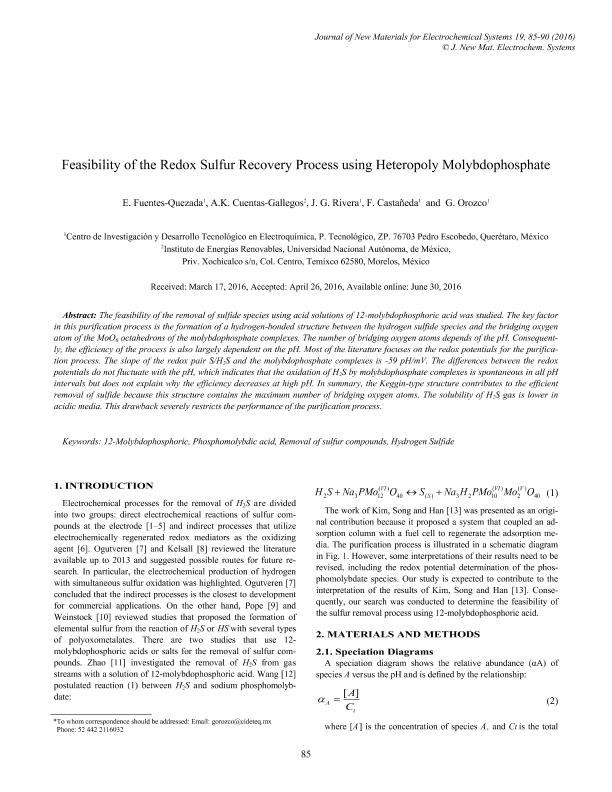Artículo
Feasibility of the Redox Sulfur Recovery Process using Heteropoly Molybdophosphate
Fuentes Quezada, Eduardo ; Cuentas Gallegos, Ana Karina; Rivera Garat, Julio Ernesto; Castañeda, F; Orozco Gamboa, G
; Cuentas Gallegos, Ana Karina; Rivera Garat, Julio Ernesto; Castañeda, F; Orozco Gamboa, G
 ; Cuentas Gallegos, Ana Karina; Rivera Garat, Julio Ernesto; Castañeda, F; Orozco Gamboa, G
; Cuentas Gallegos, Ana Karina; Rivera Garat, Julio Ernesto; Castañeda, F; Orozco Gamboa, G
Fecha de publicación:
06/2016
Editorial:
Ecole Polytechnique de Montreal
Revista:
Journal Of New Materials For Electrochemical Systems
ISSN:
1480-2422
Idioma:
Inglés
Tipo de recurso:
Artículo publicado
Clasificación temática:
Resumen
The feasibility of the removal of sulfide species using acid solutions of 12-molybdophosphoric acid was studied. The key factor in this purification process is the formation of a hydrogen-bonded structure between the hydrogen sulfide species and the bridging oxygen atom of the MoO6 octahedrons of the molybdophosphate complexes. The number of bridging oxygen atoms depends of the pH. Consequently, the efficiency of the process is also largely dependent on the pH. Most of the literature focuses on the redox potentials for the purification process. The slope of the redox pair S/H2S and the molybdophosphate complexes is -59 pH/mV. The differences between the redox potentials do not fluctuate with the pH, which indicates that the oxidation of H2S by molybdophosphate complexes is spontaneous in all pH intervals but does not explain why the efficiency decreases at high pH. In summary, the Keggin-type structure contributes to the efficient removal of sulfide because this structure contains the maximum number of bridging oxygen atoms. The solubility of H2S gas is lower in acidic media. This drawback severely restricts the performance of the purification process.
Archivos asociados
Licencia
Identificadores
Colecciones
Articulos(SEDE CENTRAL)
Articulos de SEDE CENTRAL
Articulos de SEDE CENTRAL
Citación
Fuentes Quezada, Eduardo; Cuentas Gallegos, Ana Karina; Rivera Garat, Julio Ernesto; Castañeda, F; Orozco Gamboa, G; Feasibility of the Redox Sulfur Recovery Process using Heteropoly Molybdophosphate; Ecole Polytechnique de Montreal; Journal Of New Materials For Electrochemical Systems; 19; 2; 6-2016; 85-90
Compartir



